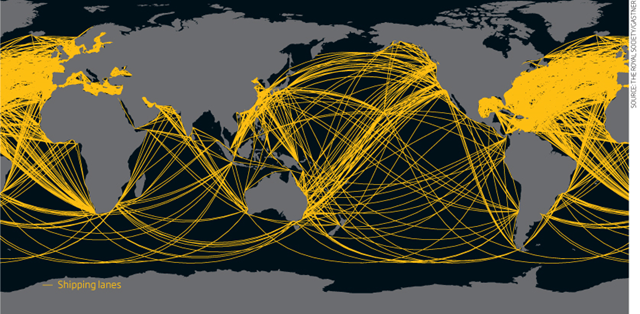

| Visitors Now: | |
| Total Visits: | |
| Total Stories: |

| Story Views | |
| Now: | |
| Last Hour: | |
| Last 24 Hours: | |
| Total: | |
Soot from oil-burning ships may be geoengineering by accident
By Jeff Hecht
9 February 2013(New Scientist) – Geoengineering is being tested – albeit inadvertently – in the north Pacific. Soot from oil-burning ships is dumping about 1000 tonnes of soluble iron per year across 6 million square kilometres of ocean, new research has revealed.
Fertilising the world’s oceans with iron has been controversially proposed as a way of sucking carbon dioxide out of the atmosphere to curb global warming. Some geoengineers claim releasing iron into the sea will stimulate plankton blooms, which absorb carbon, but ocean processes are complex and difficult to monitor in tests.
“Experiments suggest you change the population of algae, causing a shift from fish-dominated to jellyfish-dominated ecosystems,” says Alex Baker of the University of East Anglia, UK. Such concerns led the UN Convention on Biological Diversity (CBD) to impose a moratorium on geoengineering experiments in 2010.
The annual ship deposition is much larger, if less concentrated, than the iron released in field tests carried out before the moratorium was in place. Yet because ship emissions are not intended to alter ocean chemistry, they do not violate the moratorium, says Jim Thomas of the ETC Group, a think tank that consults for the CBD. “If you intentionally drove oil-burning ships back and forth as a geoengineering experiment, that would contravene it.”
The new study, by Akinori Ito of the Japan Agency for Marine-Earth Science and Technology, is the first to quantify how shipping deposits iron in parts of the ocean normally deficient in it. Earlier models had assumed that only 1 to 2 per cent of the iron contained in aerosols, including shipping emissions, is soluble in seawater, so the remaining 98 to 99 percent would sink to the bottom without affecting ocean life. But Ito found that up to 80 per cent of the iron in shipping soot is soluble (Global Biogeochemical Cycles, doi.org/kdj). As this soot rapidly falls to the sea surface, it is likely to be fertilising the oceans. [more]
Sooty ships may be geoengineering by accident
2013-02-09 11:30:43
Source: http://www.desdemonadespair.net/2013/02/soot-from-oil-burning-ships-may-be.html
Source:



